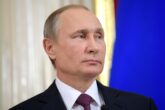April 29, 2019
Challenge Accepted: Why America Needs to Confront Its Adversaries in the Gray Zone
The return of great-power competition has dominated the national-security discussion in the United States since the release of the 2018 National Defense Strategy. However, little of it has been spent focusing on the previous era of great-power competition during the Cold War. Even a cursory exploration of that time-period will turn up documents that demonstrate the benefits of a better understanding of Cold War history. One example is a lecture delivered by the Chief of Naval Operations (CNO), Adm. Arleigh A. Burke, to the Naval War College in December of 1958.
The themes touched on by Admiral Burke’s address “The U.S. Navy’s Role in General War and Conflict Short of General War” still resonate today. The geopolitical situation it describes eerily resembles our present era. In fact, it’s not a stretch to say that with a few minor revisions the CNO could deliver the same address today. And while his blunt statement that the Sino-Soviet Bloc is America’s enemy might not survive in today’s political environment, his arguments are the same as those listed in the National Defense Strategy for classifying China and Russia as the United States’ primary competitors.
The National Defense Strategy states China and Russia are working to “shape a world consistent with their authoritarian model—gaining veto authority over other nations’ economic, diplomatic, and security decisions.” It also highlights China’s “all-of-nation long-term strategy” of economic coercion and influence operations and Russia’s subversive practices as a campaign designed to undermine the international order and change the “rules of the road.” Those conclusions rhyme with Admiral Burke’s earlier description of the Communist bloc’s fight against the Free World across “the fields of politics, of economics, of psychology, and of culture” to “disintegrate the institutions of the Free World.” Consequently, the geopolitical situation today can be viewed as merely a resumption of Cold War dynamics after a brief interruption. In this light, a close reading of Admiral Burke’s address provides a host of useful insights.
Read the full article in The National Interest.
More from CNAS
-
The Eurasian Century: Hot Wars, Cold Wars, and the Making of the Modern World with Hal Brands
For more than 100 years, the continent of Eurasia has played a central role in global geopolitics. In the 20th century, numerous authoritarian powers from Germany under Kaiser...
By Andrea Kendall-Taylor, Jim Townsend & Hal Brands
-
Putin’s Fight Won’t End With Ukraine
In an essay for Foreign Affairs, titled “Putin’s Point of No Return,” Andrea Kendall-Taylor, senior fellow and director of the Transatlantic Security Program at the Center for...
By Andrea Kendall-Taylor
-
Trump’s Callout of Russia’s Vladimir Putin Is Raising Eyebrows
President Trump is threatening sanctions and tariffs on Russia if Putin doesn't reach an agreement to end the war in Ukraine. Some are surprised, considering Trump's affinity ...
By Andrea Kendall-Taylor
-
Articulate a Comprehensive, Coherent China Strategy
President Trump should articulate a comprehensive, coherent China strategy that addresses U.S. objectives, the ways and means to achieve them, and how the strategy can mitigat...
By Jacob Stokes




